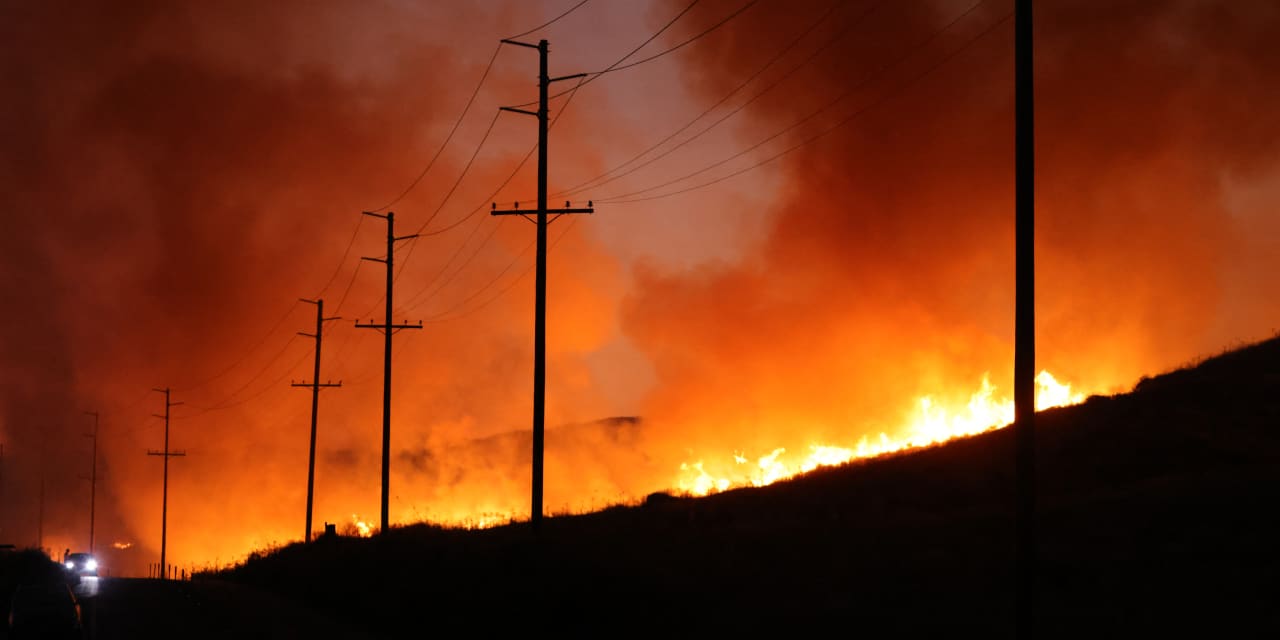The Rabbit Fire in California this summer.
David Swanson/Getty Images
California regulators are making reforms to the state’s insurance system, as companies flee amid rising climate risk that they say they aren’t properly compensated for.
First, a bit of context. Property insurers are feeling increasing financial pressure: Drier and hotter weather in California has caused more frequent and intense wildfires in recent years. Of the top 20 most destructive wildfires in California history, 14 have occurred since 2015.
High claim losses have driven up insurance costs for plenty of California homeowners. Still, many insurers have complained that state regulations prevent them from charging enough to justify the risks taken.
Despite high fire risk, the state’s average home insurance rate is $1,225 per year for $250,000 in dwelling coverage, about 14% lower than the national average, according to Bankrate.
For years, insurers in California have only been able to set their prices based on historical losses. That means if a property has not suffered from natural disasters in the past, insurers cannot charge the homeowner higher premiums—even if it’s in a wildfire-prone area.
The backward-looking pricing models are problematic, according to the insurance industry. Global warming is changing weather patterns in many parts of the world, and the past is no longer a good predictor of the future any more, they say.
“We don’t think this makes any sense because today’s climate is very different from 20 years ago,” Rex Frazier, president of the Personal Insurance Federation of California, told Barron’s in June.
Insurance companies have been using so-called “catastrophe modeling” to predict how future climate change could affect different regions of the U.S.—by analyzing temperature trends, wind patterns, property locations, and resilient measures.
Such considerations are allowed in most states, but not in California. The state regulator was worried that the already obscure pricing models might become even less transparent, and that insurers could inflate prices by overstating how risky an area truly is.
That’s changing now. This week, California Insurance Commissioner Ricardo Lara said the state will allow insurers to consider the future risk of climate change when setting prices.
“We are in really unchartered territory and we must make difficult choices when the world is changing rapidly,” Lara said at a news conference.
The new rule would likely drive up insurance costs in areas under wildfire threat, but it’s not necessarily a bad thing.
Inadequate pricing has driven many insurers away from California, as they believe it’s no longer profitable to underwrite properties in a state with high risk but low revenue. Over the past year, many have either stopped renewing policies or cut off new business in the state.
As private options continue to dry up, scores of homeowners have been forced to purchase policies from the California FAIR Plan, the state’s last-resort insurance for high-risk properties. Still, that didn’t take the burden off insurers, each of which have to chip in to back the public plan’s pool of funds.
In exchange for more freedom in pricing, Lara wants insurers to write more policies in high-risk areas. If a company has a market share of 10% across the state, it would have to write at least 8.5% of policies in wildfire-prone communities. This would help move many policyholders off the state’s FAIR plan.
The reform was applauded by the insurance industry. The American Property Casualty Insurance Association said California’s 35-year-old regulatory system is “outdated, cumbersome and fails to reflect the increasing catastrophic losses consumers and businesses are facing.”
“We urgently need to begin enacting reforms to try and repair the insurance market and protect consumer access to coverage,” says Denni Ritter, APCIA’s department vice president for state government relations.
“It is painfully clear the current system is not working properly,” the Personal Insurance Federation of California wrote in a Thursday statement. “Today’s actions are an important first step in stabilizing California’s insurance market.”
The trade group says it looks forward to the next steps in the reform that could “signal the realities of what it will take to adapt to climate change.” Lara said his team will verify the insurers’ models to make sure they’re accurate.
Write to Evie Liu at [email protected]
Read the full article here










